
This article relates to the flora of New Zealand, especially indigenous strains. New Zealand's geographical isolation has meant the country has developed a unique variety of native flora. However, human migration has led to the importation of many other plants as well as widespread damage to the indigenous flora, especially after the advent of European colonisation, due to the combined efforts of farmers and specialised societies dedicated to importing European plants & animals.

The southern brown kiwi, tokoeka, or common kiwi is a species of kiwi from South Island, New Zealand. Until 2000 it was considered conspecific with the North Island brown kiwi, and still is by some authorities.

The great spotted kiwi, great grey kiwi or roroa is a species of kiwi endemic to the South Island of New Zealand. The great spotted kiwi, as a member of the ratites, is flightless. It is the largest of the kiwi. The rugged topography and harsh climate of the high altitude alpine part of its habitat render it inhospitable to a number of introduced mammalian predators, which include dogs, ferrets, cats, and stoats. Because of this, populations of this species have been less seriously affected by the predations of these invasive species compared to other kiwi. Nonetheless, there has been a 43% decline in population in the past 45 years, due to these predators and habitat destruction. This has led it to be classified as vulnerable. There are less than 16,000 great spotted kiwis in total, almost all in the more mountainous parts of northwest Nelson, the northwest coast, and the Southern Alps. A minority live on island reserves.
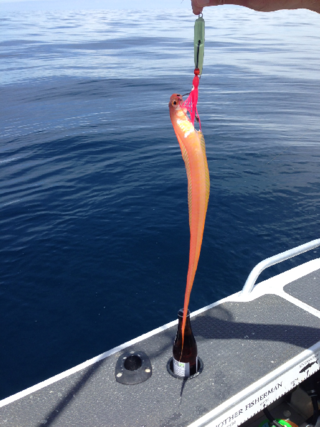
Cepola haastii is a species of marine ray-finned fish belonging to the family Cepolidae, the bandfishes. It is found on the inner continental shelf around New Zealand. Its length is between 15 and 25 cm. This species is known as the red bandfish, a name given to most of the other members of the genus Cepola, especially the European species, Cepola macrophthalma.

Celmisia is a genus of perennial herbs or subshrubs, in the family Asteraceae. Most of the species are endemic to New Zealand; several others are endemic to Australia.
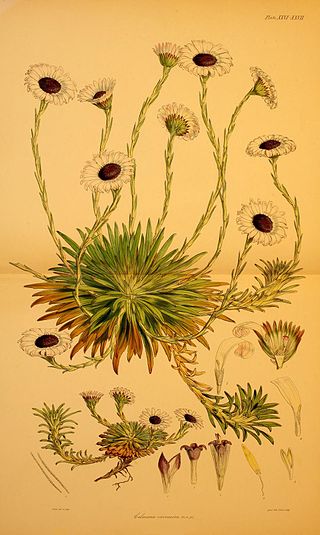
Damnamenia is a genus of flowering plants in the family Asteraceae.

Celmisia spectabilis is one of the more widespread species in the mountainous areas of New Zealand, where it is commonly known as the cotton daisy. Belonging to the family Asteraceae, this species has leathery leaves that are ovate to lanceolate or narrowly oblong, and can reach 30 cm long. They have a shiny, green upper surface, with prominent parallel grooves, but their undersides are densely covered in soft, whitish or buff-coloured hairs. The leaf bases overlap and compact to form a stout pseudostem. Plants can form mats up to 2 m across.
Celmisia tomentella is a species of perennial herb in the family Asteraceae. Leaves are 5 to 30 cm long and 5 to 15 mm wide, with a dark green or grey green upper surface. The daisy-like flowerheads, which are 6 to 8 cm in diameter, appear between December and February in the species native range. The species was first formally described in 1999 in New species and a new combination in Australian Celmisia (Asteraceae-Astereae) published in Australian Systematic Botany. It occurs in woodland, heath and bogs in subalpine areas including the Baw Baw plateau, the Bogong High Plains and Mount Buffalo in Victoria and northward into south-eastern New South Wales.
Daisy Jugadai Napaltjarri was a Pintupi-Luritja-speaking Indigenous artist from Australia's Western Desert region, and sister of artist Molly Jugadai Napaltjarri. Daisy Jugadai lived and painted at Haasts Bluff, Northern Territory. There she played a significant role in the establishment of Ikuntji Women's Centre, where many artists of the region have worked.

Stigmella childi is a species of moth of the family Nepticulidae. It is endemic to New Zealand and has been observed in the southern parts of the South Island. This species inhabits subalpine and alpine grassland and herbfields. The larvae of this species are leaf miners and feed on the leaves of Celmisia haastii. Adults have been observed on the wing in January.
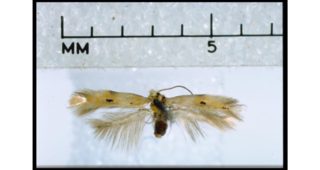
Stigmella insignis is a moth of the family Nepticulidae. It is endemic to New Zealand and has been observed in the Hawkes Bay as well as in the north west of the South Island. S. insignis inhabits montane to subalpine grasslands. The larvae of S. insignis are leaf miners. They likely feed on Celmisia spectabilis. Adults of this species have been observed on the wing in March, November and December.

Stigmella oriastra is a moth of the family Nepticulidae. It is found in New Zealand.
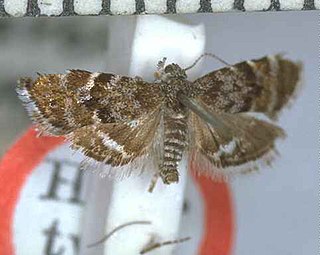
Asterivora marmarea is a species of moth in the family Choreutidae. It is endemic to New Zealand and lives in mountainous habitats. It has been observed in the lower parts of the North Island and the upper South Island. The larval host of this species is Celmisia gracilenta and adults of this species are on the wing in December and January.
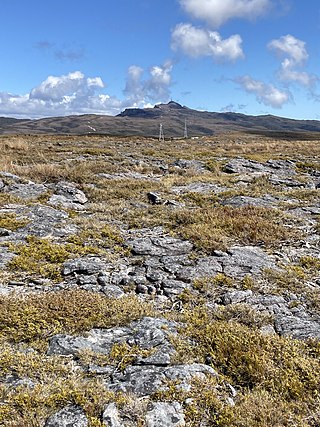
Denniston Plateau is an 18 km long, 600–800 m high coalfield plateau in the Papahaua Range on the West Coast of the South Island of New Zealand. A combination of impermeable rock, high rainfall, and shallow acidic soil has created a unique ecosystem of stunted trees and heath-like vegetation which is home to numerous endemic and undescribed species of plants and invertebrates. The plateau contains rich seams of high-quality coal, which led to the creation and abandonment of the mining towns of Denniston and Millerton, and the current Stockton Mine. Plans to create a new open-cast mine on the southern part of the plateau have become an environmental controversy.
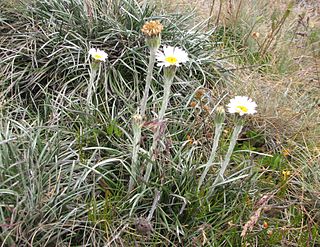
Celmisia pugioniformis, commonly known as slender snow-daisy, is a species of perennial herb in the family Asteraceae. It is native to south-eastern Australia. Leaves are 10 to 20 cm long and 2 to 6 mm wide, with an olive green or grey green upper surface. The daisy-like flowerheads, which are 6 to 8 cm in diameter, appear between December and February in the species native range. The species was formally described in 1992 in the Flora of New South Wales. Prior to 1992, plants had been included under the name Celmisia asteliifolia.

Gelophaula aenea is a species of moth of the family Tortricidae. It is endemic to New Zealand.

Kiwalges haastii is a species of New Zealand feather mite in the superfamily Analgoidea, known only from the great spotted kiwi, from which it derives its name.

Celmisia angustifolia, called the strap-leaved daisy, is a species of flowering plant in the genus Celmisia, native to the South Island of New Zealand. It has gained the Royal Horticultural Society's Award of Garden Merit.

Celmisia major is a species of daisy that is endemic to New Zealand. It is split into two different varieties, Celmisia major var. major and Celmisia major var. brevis. Despite being in the same species, it is thought that the two varieties are not close to one another, with botanist Peter James de Lange stressing critical study on the taxonomy of the daisies. It was first described by Thomas Cheeseman in 1925. The major variety is found in the Auckland area and nearby islands, while the brevis variety is confined to Mount Taranaki.

Celmisia verbascifolia is a species of daisy that is endemic to New Zealand. It was first described by Joseph Dalton Hooker in 1853.


















